



ORGANS OF PARIS © 2024 Vincent Hildebrandt HOME ALL ORGANS

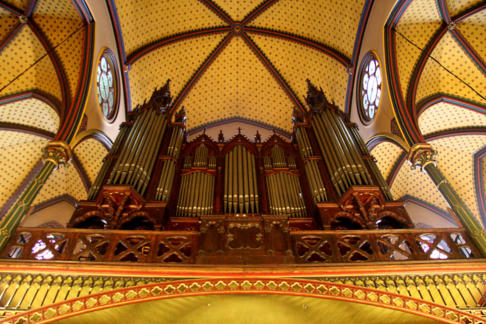
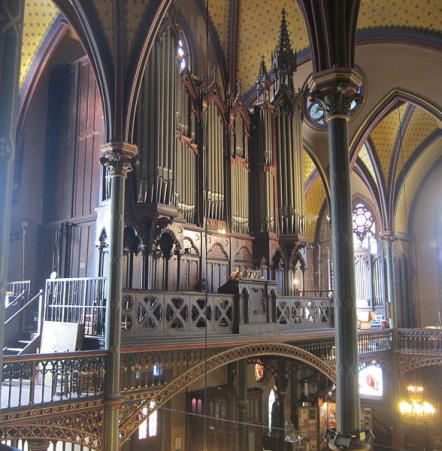
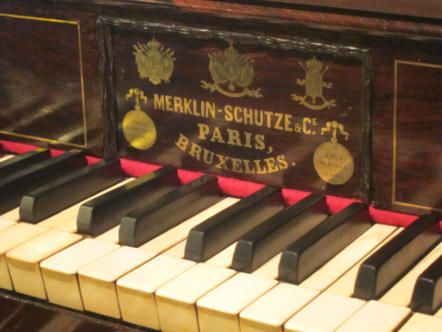
Saint-Eugène (home of the ‘Paroisse St-Eugène-Sainte
Cécile’) was built in 1854-1856 in a 13th century style
(exterior) and a neo-gothic style (interior), using metal
instead of stone. The remarkable preserved 19th
century interior shows an abundance of lights and a
richness of the colours. The architects were Louis-
Auguste Boileau and Adrien-Louis Lusson.

C1
The organ of Saint Eugène is of the utmost importance: it
was the first organ of Merklin and his voicer Friedrich
Schütze in France/Paris, built in 1854-55. It is almost
entirely authentic and a rare example of a synthesis
between French and German-Flemish organ building
traditions at that time.
The organ case, in perfect harmony with the surrounding
building, was designed by Louis-Auguste Boileau, the
church architect.
The organ was largely constructed in Bruxelles, just before
Merklin moved to Paris and acquired the Parisian firm of
Ducroquet (former Daublaine-Callinet firm).
The organ was presented at the Paris World Fair in 1855,
and was awarded a First Class Prize. Since Merklin wanted
to present a master piece at the World Fair, he enlarged the
organ (originally designed as a two-manual organ) with a
third keyboard and five additional stops. The enlarged
organ was installed and inaugurated in Saint Eugène in
1856.
There are several distinctive features which make this
organ exceptional and remarkable:
1.
All windchests are cone-valve chests, each pipe having
its own valve. Merklin learned about cone-valve
windchests from Walcker of Ludwigsburg during his
appprentice years.
2.
The Récit is a real third manual (in contrast to the
small ‘Echo’ which was common before)
3.
The action of the organ is mechanical with a Barker
machine on the Récit division to which the coupler
machine is linked. The Récit manual (added after the
original conception of the instrument) is thus the
accumulating keyboard. By acquiring the Daublaine-
Callinet firm, Merklin was assured of the expertise of
Barker, who was the leading expert of this former
firm.
4.
The stops are almost entirely original, with a large
variety (11) of eight foot stops, three flûtes
harmoniques (flûte ouverte GO, flûte octaviante 4 GO
and the flûte harmonique Récit (the flûte harmonique
4 Récit is in fact not harmonic!) and the use of stops of
German origin: gemshorn (Corne de Chamois), Dolce
(very soft flute), Dolciana. A Voix Céleste is missing.
The Clarinette is an extraordinary stop, having two
ranks: a free reed 8 (Clarinette) and a Bourdon 8
starting at c. These two ranks sound together, but it is
possible to open or close only the reeds in the interior
of the organ. This is useful for the tuning of the
bourdon and, by closing the reeds, one creates one
additional foundation stop!
5.
The first use in France of voicing curls (in French:
entailles d‘accord).
The organ was restored with great care and craftsmanship
by Olaf Dalsbaek (Dalsbaek - Merklin company at Miribel )
and inaugurated in 2005.
Source:
Olaf Dalsbaek & Roland Galtier L’orgue Merklin-Schütze de
l’église Saint-Eugène-Saint-Cécile à Paris : une singularité dans
la facture du Second Empire. La Flûte Harmonique Numéro 92,
année 2011 - Association Aristide Cavaillé-Coll (in French)
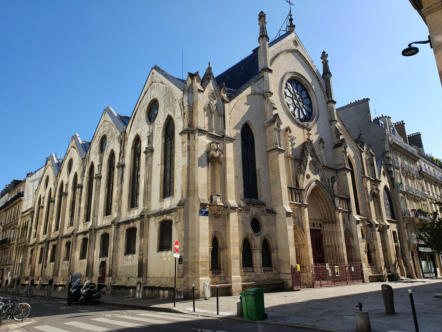
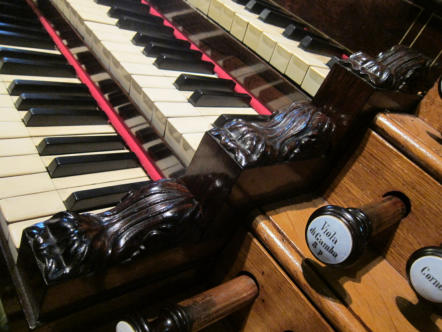
Organiste titulaire
Touve R. Ratovondrahety
Concerts
Seldomly
Masses with organ
Sunday 9:45, 11:00 AM (Forme Extraordinaire),
5:45 PM(Vêpres), 7:00 PM (Messe basse)
Videos
Touve R. Ratovondrahety
Philippe Ourselin
Photo GO: Jeroen de Haan
Other photos: Gaspard de La Motte
The organs of Paris
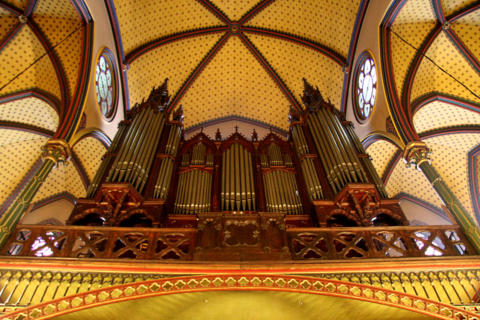
ORGANS OF PARIS © 2024 Vincent Hildebrandt ALL ORGANS
Organiste titulaire
Touve R. Ratovondrahety
Concerts
Seldomly
Masses with organ
Sunday 9:45, 11:00 AM (Forme Extraordinaire),
5:45 PM(Vêpres), 7:00 PM (Messe basse)
Videos
Touve R. Ratovondrahety
Philippe Ourselin
Photo GO: Jeroen de Haan
Other photos: Gaspard de La Motte
C1
The organ of Saint Eugène is of the utmost importance: it was
the first organ of Merklin and his voicer Friedrich Schütze in
France/Paris, built in 1854-55. It is almost entirely authentic
and a rare example of a synthesis between French and
German-Flemish organ building traditions at that time.
The organ case, in perfect harmony with the surrounding
building, was designed by Louis-Auguste Boileau, the church
architect.
The organ was largely constructed in Bruxelles, just before
Merklin moved to Paris and acquired the Parisian firm of
Ducroquet (former Daublaine-Callinet firm).
The organ was presented at the Paris World Fair in 1855, and
was awarded a First Class Prize. Since Merklin wanted to
present a master piece at the World Fair, he enlarged the
organ (originally designed as a two-manual organ) with a third
keyboard and five additional stops. The enlarged organ was
installed and inaugurated in Saint Eugène in 1856.
There are several distinctive features which make this organ
exceptional and remarkable:
1.
All windchests are cone-valve chests, each pipe having its
own valve. Merklin learned about cone-valve windchests
from Walcker of Ludwigsburg during his appprentice
years.
2.
The Récit is a real third manual (in contrast to the small
‘Echo’ which was common before)
3.
The action of the organ is mechanical with a Barker
machine on the Récit division to which the coupler
machine is linked. The Récit manual (added after the
original conception of the instrument) is thus the
accumulating keyboard. By acquiring the Daublaine-
Callinet firm, Merklin was assured of the expertise of
Barker, who was the leading expert of this former firm.
4.
The stops are almost entirely original, with a large variety
(11) of eight foot stops, three flûtes harmoniques (flûte
ouverte GO, flûte octaviante 4 GO and the flûte
harmonique Récit (the flûte harmonique 4 Récit is in fact
not harmonic!) and the use of stops of German origin:
gemshorn (Corne de Chamois), Dolce (very soft flute),
Dolciana. A Voix Céleste is missing. The Clarinette is an
extraordinary stop, having two ranks: a free reed 8
(Clarinette) and a Bourdon 8 starting at c. These two
ranks sound together, but it is possible to open or close
only the reeds in the interior of the organ. This is useful
for the tuning of the bourdon and, by closing the reeds,
one creates one additional foundation stop!
5.
The first use in France of voicing curls (in French: entailles
d‘accord).
The organ was restored with great care and craftsmanship by
Olaf Dalsbaek (Dalsbaek - Merklin company at Miribel ) and
inaugurated in 2005.
Source:
Olaf Dalsbaek & Roland Galtier L’orgue Merklin-Schütze de l’église
Saint-Eugène-Saint-Cécile à Paris : une singularité dans la facture
du Second Empire. La Flûte Harmonique Numéro 92, année 2011
- Association Aristide Cavaillé-Coll (in French)






















